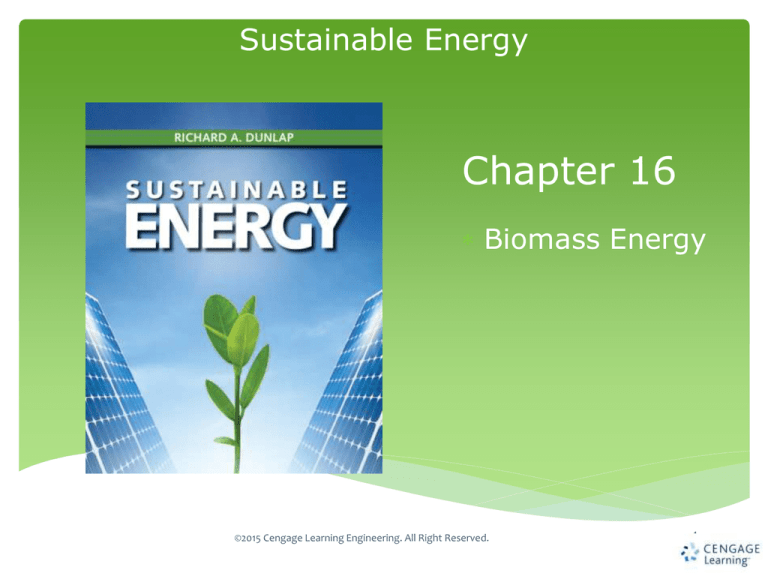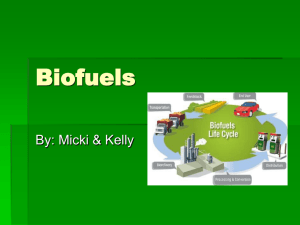
Sustainable Energy
Chapter 16
Biomass Energy
©2015 Cengage Learning Engineering. All Right Reserved.
1
Sustainable Energy
Dunlap
Learning Objectives
●
●
●
●
●
●
The properties of wood and its uses for energy.
The production and use of ethanol and
methanol.
A comparison of the Brazilian and U.S. ethanol
programs.
Biodiesel production.
Environmental consequences of biofuel
utilization.
The use of municipal waste for energy
production.
©2015 Cengage Learning Engineering. All Right Reserved.
2
Sustainable Energy
Dunlap
Biofuels
Biofuels are hydrocarbon based materials which
are extracted from recently grown organic
matter.
Biofuels produce greenhouse gases (CO2), as do
fossil fuels, but are carbon neutral if new organic
material is grown to replace that which is burned.
©2015 Cengage Learning Engineering. All Right Reserved.
3
Sustainable Energy
Dunlap
Types of biofuels
Biofuels that are covered in this chapter can
be classified as
•
•
•
•
Wood and wood products
Ethanol
Biodiesel
Municipal solid waste
©2015 Cengage Learning Engineering. All Right Reserved.
4
Sustainable Energy
Dunlap
Relative proportions of energy sources
worldwide
©2015 Cengage Learning Engineering. All Right Reserved.
5
Sustainable Energy
Dunlap
Wood
Wood is the oldest source of energy used by
humans.
Wood remained the major source of energy in
industrialized nations until late 1800s when it
was replaced by coal.
©2015 Cengage Learning Engineering. All Right Reserved.
6
Sustainable Energy
Dunlap
Types of wood fuel products
Wood is used as a fuel in three forms
• Firewood - wood as harvested
• Charcoal - relatively pure carbon produced by
heating wood
• Black liquor - combustible oil-like liquid which is a
by-product of the paper industry
©2015 Cengage Learning Engineering. All Right Reserved.
7
Sustainable Energy
Dunlap
Proportions of different wood products
Most wood that is used for energy production is used as
firewood - Asia and Africa are the principal users
©2015 Cengage Learning Engineering. All Right Reserved.
8
Sustainable Energy
Dunlap
Ethanol
Properties of light alcohols
Ethanol is a light alcohol and is one of the hydrated alkanes
©2015 Cengage Learning Engineering. All Right Reserved.
9
Sustainable Energy
Dunlap
Sources of ethanol
Ethanol is a by-product of the distillation of petroleum.
Ethanol can also be produced by the fermentation of sugar
containing biological material (sometimes called bioethanol).
This accounts for about 90% of all ethanol production.
Ethanol is convenient as a direct replacement for liquid fossil
fuels (e.g. gasoline).
©2015 Cengage Learning Engineering. All Right Reserved.
10
Sustainable Energy
Dunlap
Chemistry of ethanol
Glucose is produced by photosynthesis
Ethanol is produced from glucose by fermentation
Energy can be extracted from ethanol by combustion
Note that 6CO2 are used to produce glucose. 2CO2 are
released during fermentation and 4CO2 are released
during combustion, giving net zero carbon emissions.
©2015 Cengage Learning Engineering. All Right Reserved.
11
Sustainable Energy
Dunlap
Steps in the production of ethanol
• Fermentation
• Distillation
• Dehydration
©2015 Cengage Learning Engineering. All Right Reserved.
12
Sustainable Energy
Dunlap
Fermentation
Simple sugars and starches can be used to
produce ethanol by fermentation.
More complex processes are needed to
produce ethanol from cellulose.
These processes are not yet economical.
©2015 Cengage Learning Engineering. All Right Reserved.
13
Sustainable Energy
Dunlap
Distillation
Fermentation products contain water and this
must be removed to produce a combustible fuel.
Traditional distillation methods produce a mixture
of about 96% ethanol and 4% water.
The presence of 4% water makes the ethanol
immiscible in gasoline and limits its use as a
transportation fuel.
©2015 Cengage Learning Engineering. All Right Reserved.
14
Sustainable Energy
Dunlap
Dehydration
Excess water may be removed from ethanol
using molecular sieves.
©2015 Cengage Learning Engineering. All Right Reserved.
15
Sustainable Energy
Dunlap
Uses of ethanol
Ethanol commonly blended with gasoline in
different proportions
• E10 refers to 10% ethanol 90% gasoline
• E85 refers to 85% ethanol 15% gasoline
• E100 refers to 100% ethanol
An unmodified gasoline internal combustion
engine will run on up to 10% ethanol without
problems.
©2015 Cengage Learning Engineering. All Right Reserved.
16
Sustainable Energy
Dunlap
Use of E10 in North America
Much of the gasoline
sold commercially in
North America is
actually E10.
©2015 Cengage Learning Engineering. All Right Reserved.
17
Sustainable Energy
Dunlap
Flex fuel vehicles
Modifications to the fuel
delivery system will allow a
gasoline engine to run on
ethanol mixtures up to E85.
Flex fuel vehicles are common
in North America but E85 is
available at only about 1% of
gasoline stations.
©2015 Cengage Learning Engineering. All Right Reserved.
18
Sustainable Energy
Dunlap
Energy content of ethanol
Ethanol energy content is 23.5 MJ/L compared
with gasoline at 34.8 MJ/L.
Running a gasoline vehicle of ethanol or ethanol
blends will increase the fuel consumption and
reduce the driving range.
©2015 Cengage Learning Engineering. All Right Reserved.
19
Sustainable Energy
Dunlap
Ethanol production by country
United States is the major producer
©2015 Cengage Learning Engineering. All Right Reserved.
20
Sustainable Energy
Dunlap
Growth of ethanol production
©2015 Cengage Learning Engineering. All Right Reserved.
21
Sustainable Energy
Dunlap
Comparison of U.S. and Brazil ethanol use
©2015 Cengage Learning Engineering. All Right Reserved.
22
Sustainable Energy
Dunlap
Important differences between U.S. and Brazil
Fraction of fuel:
• U.S. ethanol is minor component of
transportation fuel
• Brazil ethanol is the major component of
transportation fuel
Energy balance:
• U.S. 1.4 MJ ethanol energy output per 1 MJ
energy input
• Brazil 9.2 MJ ethanol energy output for 1 MJ
energy input
©2015 Cengage Learning Engineering. All Right Reserved.
23
Sustainable Energy
Dunlap
Importance of climate and agriculture
• Brazil has longer average growing season
• U.S. mostly corn, Brazil mostly sugar cane
• Sugar cane has a higher glucose content but does not
grow in most of the U.S.
• Brazil has developed a more efficient ethanol production
infrastructure
• U.S. agriculture largely mechanized and uses fossil fuels
• Brazil agriculture much less mechanized
©2015 Cengage Learning Engineering. All Right Reserved.
24
Sustainable Energy
Dunlap
Biodiesel
Biodiesel is a direct replacement for petroleum derived diesel
fuel
Biodiesel produced from waste or low grade vegetable oil
and/or animal fat
Blended with petroleum diesel
• B5 is 5% biodiesel, 95% petroleum diesel
• B99 is 99% biodiesel, 1% petroleum diesel
©2015 Cengage Learning Engineering. All Right Reserved.
25
Sustainable Energy
Dunlap
Biodiesel productivity from
different plant sources
©2015 Cengage Learning Engineering. All Right Reserved.
26
Sustainable Energy
Dunlap
Growth of biodiesel production
Europe (Germany in particular) has been most active in
biodiesel production
©2015 Cengage Learning Engineering. All Right Reserved.
27
Sustainable Energy
Dunlap
Net environmental impact of biofuels
Greenhouse gas emissions and total environmental impact of
biofuels has been analyzed.
Most alternative fuels emit less CO2 per unit energy than
gasoline.
Many, however, have greater total environmental impact.
These include
• ethanol from sugarcane (Brazil) - worse than gasoline
• ethanol from corn (U.S.) - much worse than gasoline
©2015 Cengage Learning Engineering. All Right Reserved.
28
Sustainable Energy
Dunlap
GHG emissions and environmental impact
normalized to gasoline
©2015 Cengage Learning Engineering. All Right Reserved.
29
Sustainable Energy
Dunlap
Municipal solid waste
Much of municipal solid waste (MSW) is combustible and can
be used to generate energy.
Two approaches to obtaining energy from MSW
• Burn the combustible component of MSW directly to
produce heat to make steam and rive a turbine
• Use methane produced by MSW decomposition to burn to
make steam
©2015 Cengage Learning Engineering. All Right Reserved.
30
Sustainable Energy
Dunlap
Amount of MSW
MSW production has increased in the U.S. - Currently about
twice the mass per capita of most industrialized countries
©2015 Cengage Learning Engineering. All Right Reserved.
31
Sustainable Energy
Dunlap
Fraction of total energy from MSW
In the U.S. an average of 2 kg MSW per capita per day is
produced.
The average energy content of MSW is about 10 MJ/kg,
so 2 kg MSW corresponds to about 20 MJ per capita per day
or 7.3 GJ per capita per year.
This is about 2% of total per capita primary energy use.
Even if all MSW energy is utilized it represents a small
fraction of total energy need.
©2015 Cengage Learning Engineering. All Right Reserved.
32
Sustainable Energy
Dunlap
Advantages of MSW energy production
Burning MSW produces energy (and also CO2).
Putting MSW in a landfill produces no energy but can produce
methane via decomposition.
Methane is a more effective GHG than CO2..
The overall environmental impact of different MSW disposal
methods is complex problem.
©2015 Cengage Learning Engineering. All Right Reserved.
33
Sustainable Energy
Dunlap
Changes in MSW disposal methods (U.S.)
Use of MSW as a fuel has increased since 1980
©2015 Cengage Learning Engineering. All Right Reserved.
34
Sustainable Energy
Dunlap
Summary
• Biofuels can be carbon neutral if organic material is grown
to replace that which is burned
• Wood is a major source of heat in many less industrialized
countries but is a minor source of energy in North
America and Europe
• Use of ethanol as a fuel has increased in recent years
• Climate and agricultural practices are important in effective
ethanol production
• Biodiesel most commonly used in Europe
• Biodiesel production has increased rapidly
• Net environmental impact of biofuels is not entirely clear
• MSW use as a fuel is a minor component of energy needs
• Use as a fuel may be environmentally preferable to
alternate disposal methods
©2015 Cengage Learning Engineering. All Right Reserved.
35




